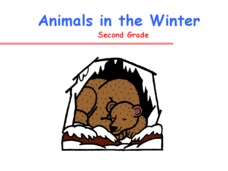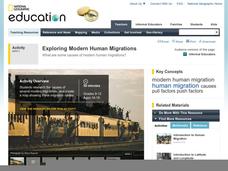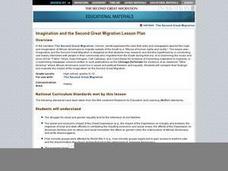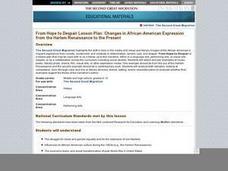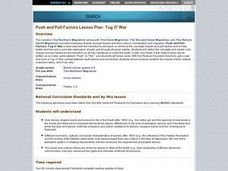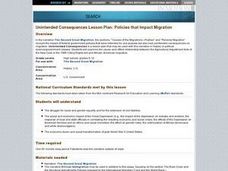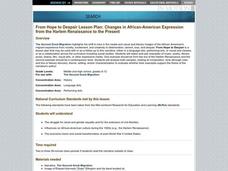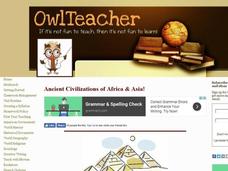Curated OER
The Second Great Migration
Students examine causes of The Second Great Migration and the impact it had on its destination communities.
Curated OER
Animals in the Winter: Second Grade
Ever wonder what animals do in winter? If your 2nd graders do then they will enjoy this PowerPoint. Each slide begins with a questions and then provides the answer, it is a short presentation but the resource links at the bottom make it...
National Geographic
Exploring Modern Human Migrations
Using maps, images, websites, and handouts, learners work to understand the nature of human migrations. They compare and contrast human migration from the past to the present, identify causes for migration, and trace migration routes on...
Curated OER
Traveler's in Time
Students analyze artifacts to become familiar with the Great Migration. In this migration lesson, students read an article and answer comprehension questions. Students role play a migration scenario using an artifact to help...
Curated OER
Imagination and the Second Great Migration
Students examine the struggle for racial and gender equality and for the extension of civil liberties. They access websites imbedded in this plan to research, then write about past struggles for gender and racial fairness.
Curated OER
U.S. History: The Second Great Migration
Learners examine the migration of rural African Americans to northern cities following World War !!. After predicting the effects of cultural and economic factors, they write essays explaining the impact of migration on communities and...
Curated OER
Changes in African-American Expression from the Harlem Renaissance to the Present
Students examine and analyze struggle for racial and gender equality, influences on African-American culture during the 1920s, and economic boom and social transformation of post-World War II United States.
Curated OER
Parallel Studies of the Afro-American and Puerto Rican Experience in America
Students compare/contrast the Afro-American and Puerto Rican experience as they migrated and assimilated in the U.S. They research and discuss the reasons for migration and the historical significance of economic autonomy and oppression.
Curated OER
Color at Light Speed
Rainbow science anyone? learners put the color specturm, frequency, light waves, and wavelengths into a light speed context. They use algebraic formulas to determine the speed of each light wave length. A great way to connect math and...
Curated OER
Push and Pull Factors: Tug O' War
Students analyze the factors that led to migration in the 19th century including the forces that drew people to resettle as well as to return a place where they previously lived.
Curated OER
Unintended Consequences: Policies that Impact Migration
Students examine the cause-and-effect relationship between the Agricultural Adjustment Acts of the New Deal or the 1965 Voting Rights Act and African-American migration. They write an essay evaluating the effectiveness of the Voting...
Curated OER
Charity throughout History
Ever stop to think about why charities exist and when they started? Take a second to look through history and discover that giving has been apart of human society since ancient Rome. Jump to the US to uncover facts about our first...
Curated OER
The Great Debate Lesson Plan: Slavery in the U.S. Constitution
Students examine the U.S. Constitution to see what has been writte about slavery. Then, students, in groups, research the Constitutional Convention of 1787 to explore slavery compromises.
Curated OER
Great River Bend Adventure
Students use their imagination. They discuss the 4 C's of teamwork: Concentration, Communications, Coomperation, and Consideration. Students discuss the safety guidelines of the project. They complete a rope maze. The group walks...
PBS
Reading Adventure Pack: Cooking
A Reading Adventure Pack focuses on cooking. Scholars participate in three hands-on activities after reading the fiction book Easy as Pie by Cari Best and the nonfiction book How Did That Get in My Lunchbox? by Chris Butterworth....
Curated OER
Agents of Erosion and Deposition
In this science worksheet, middle schoolers play a game of shoreline charades using picture symbols and other games to cover the concept of erosion or deposition.
Curated OER
Understanding Thunderstorms
In this thunderstorm worksheet, students read about thunder and lightning and the forces behind both. They also read about the timing difference between thunder and lightning. Students answer three critical thinking questions about...
Curated OER
Urban Concentration and Racial Violence
Students research one of the many urban race riots in U.S. history, from the New York City riots during the Civil War to the "Red Summer of 1919" or the hate-strikes of 1943. They present their findings in the form of a newspaper's front...
Curated OER
Interesting Facts about the Historic Trails
The Oregon trail is a very interesting part of American history. The class, having read or discussed the events leading to the westward expansion and settling of the Oregon Territory, can answer each of these fill-in-the-blank...
Curated OER
History, African Americans, The Blues
This instructional activity enables teachers to use blues music to explore the history of African Americans in the 20th century. By studying the content of blues songs, students can learn about the experiences and struggles of the...
Owl Teacher
Teach Ancient Civilizations: Africa
Amazing! Teach learners about the wonders of ancient Africa and Asia with a comprehensive set of teaching tools. You'll click to find a well-constructed presentation, a worksheet that has kids compare and contrast ancient alphabets, a...
Curated OER
How Can We Locate Specific Places On Earth?
Second graders discover how to use longitude and latitude to locate specific sites on Earth. They compare old and new ways of locating specific places, and discover how latitude and longitude coordinates are used to locate places on Earth.
Curated OER
Trails to the West
Eighth graders research American history of the 1850's. In this American history instructional activity, 8th graders write about how different American groups looked at the idea of Manifest Destiny. Students then draw the Oregon and...
Curated OER
Marine & Aquatic Habitats Activities - Estuaries Are for the Birds!
Learners recognize that birds act as indicators of pollution because of their sensitivity to environmental change, and role play the manner in which marine debris can be hazardous to waterfowl.



